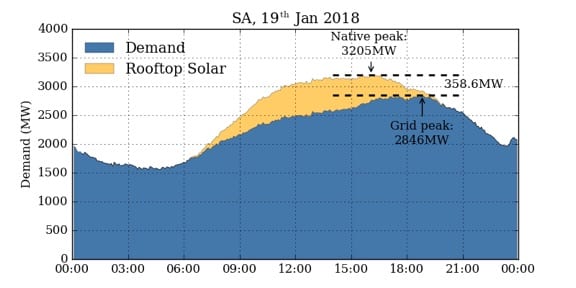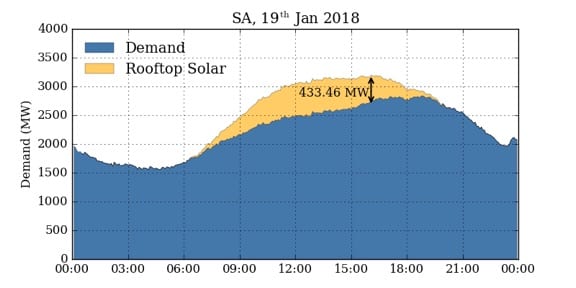Rooftop Solar Lowers Peak Electricity Demand In Australian Heatwave
Originally published on RenewEconomy
Households and businesses played a key role in reducing peak demand and capping wholesale electricity costs in South Australia last month, with data showing that rooftop solar played a major role in reducing and deferring demand peaks in the midst of the heatwave.
Solar Citizens states that rooftop solar was providing more capacity at the demand peak than would have been offered by the now-closed Northern coal-fired power station in Port Augusta.
Because of the rooftop solar capacity, and because a large chunk of it is consumed on site within the household or business that has installed the solar, grid demand (the part that needs to be actively managed by the grid operator) did not actually peak until after 6pm on both a Thursday and Friday in mid-January.
On that Thursday, solar owners produced more power than the capacity of the now-closed Northern coal-fired power station in Port Augusta (see top graph, courtesy of Dylan McConnell of the Climate and Energy College) when grid demand would have peaked just after 3pm on Thursday without the state’s solar.
“Without solar, demand on the grid would have peaked just after 3pm on Thursday,” Dan Spencer, the South Australia campaigner for Solar Citizens said in a statement.
“Instead, rooftop solar provided more power than the now-closed Northern power station in Port Augusta, keeping the lights on with clean energy.”
And on Friday, he noted, rooftop solar reduced the peak by 358.6MW “far exceeding the capacity of the government’s new backup generators.”
Indeed, as energy analyst Simon Holmes a Court notes in this separate piece, the emergency back-up diesel generators ordered by the South Australia government have yet to be switched on, despite claims by federal energy minister Josh Frydenberg.
The results from the rooftop solar capacity in South Australia are not unusual. State network operators and grid owners have reported for the last few years that rooftop solar has pushed back the peaks from mid to late afternoon to early evening.
And, for the first time in more than a century of grid power supplies, it is the customers who are having a major influence on this – a phenomenon that is set to grow as rooftop solar and other “distributed generation” grows to near 50 percent of all supply within a few decades.
“Everyday people generating their own clean power meant that peak demand was pushed back by more than 4 hours until after 7pm on Thursday and by nearly 3 hours on Friday,” Spencer wrote.
Spencer said the failure of Victorian coal plant Loy Yang B during the heatwave on Thursday highlights the need for South Australia to continue investing in renewable energy with storage.
“The failure of Victorian coal during the heatwave meant prices went up for South Australians. With a state election just around the corner, we’re calling on all parties to increase South Australia’s renewable target to bring more local renewables with storage to SA.
“Along with raising South Australia’s renewables target, we’re calling on all South Australian politicians to do more to make cost-cutting rooftop solar accessible to all South Australians,” Spencer said.
“More accessible solar means that more people will be able to take back control of their electricity bills while helping to safeguard the grid.”
South Australia has some 730MW of rooftop solar across the state, and is about to become a major player in utility-scale solar, with the opening of the 6MW Whyalla solar farm, and another 500MW being built or planned at Bungala (Port Augusta), Whyalla steel, and Tailem Bend.
Spencer has been a key campaigner for the Aurora solar thermal project, which will deliver 150MW of capacity, and more than 800MWh of storage, from a new solar tower and molten salt storage facility near Port Augusta.
The Port August office for US developer SolarReserve, is to be formally opened by Premier Jay Weatherill on Tuesday.
Have a tip for CleanTechnica? Want to advertise? Want to suggest a guest for our CleanTech Talk podcast? Contact us here.
Latest CleanTechnica.TV Video

CleanTechnica uses affiliate links. See our policy here.




